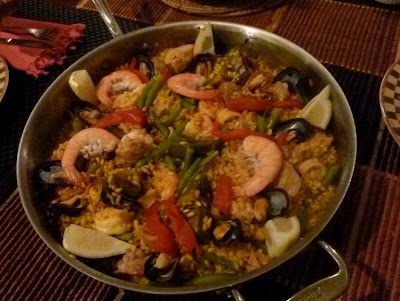 | ||||
| (Photo by Donna Gelb.) |
 |
| Paella in a New York kitchen.(Photo by David Gelb) |
Paella made-in-the-USA usually requires some substitutions. First of all, there's the problem of the paella pan. The authentic pan is wide and flat, originally intended to set over a wood fire, and doesn't fit very well on a stove top. So I rummage in kitchens until I find a deep skillet or flat-bottomed wok that will hold the rice, chicken and seafood.
The shopping list. Good extra virgin olive oil is essential for paella. It gives authentic flavor. And medium-short-grain rice. If I can't find real Spanish rice, I substitute Italian arborio rice. Shrimp, clams or mussels and squid, if I can get it, because it adds so much flavor. I like to get boneless chicken thighs and cut them into three or four pieces, so that they cook quickly with the sofrito.Green beans, cut in short lengths and par-boiled, and one artichoke, cut in sixths and added to the sofrito.
| Paella ingredients. |
Once all the ingredients are prepped, the cooking takes less than an hour--about 20 minutes for the sofrito, 20 minutes for the rice and another 10 minutes for the paella to rest.
Paella is a process of developing flavor, as each ingredient is added to the pan. Don't fret about the chicken or the shrimp overcooking--it's purpose is to produce flavorful rice. I like to use some unpeeled shrimp to garnish the finished paella. I saute them in the oil before beginning the sofrito, as that adds flavor to the oil.
| Shrimp to flavor the olive oil. |
In my own kitchen in Spain, I make a stock of shrimp heads and peels, chicken bones, plus liquid from steaming open clams or mussels. But working in someone else's kitchen, I find it easier to purchase ready-made low-sodium chicken broth. Either add the broth to the pan and bring it to a boil before adding the rice or else heat the broth in another pan and add to the rice in the paella.
| Daniel adds shrimp to the paella. |
About the saffron: because it's so expensive to buy in the US, I bring it from Spain. I try to find only the best saffron with denominacion de origen La Mancha. Crush the saffron threads in a small mortar (or tea cup if you don't have a mortar) and add about 1/4 cup very warm water. Let the saffron infuse 10 minutes or longer. If you don't have saffron, use a drop or two of yellow food coloring plus pimenton (Spanish paprika, but not the smoked kind).
| Dinner guest, Giselle, helps with the paella. |
One important tip: once the rice, chicken, seafood and broth have been combined, bring everything to a boil, then DON'T STIR THE PAELLA AGAIN. Unlike risotto, for paella, you want to avoid developing the starch, or the rice will be gummy. Cook on a high heat for about 5 minutes, then turn the heat down to a simmer and cook until the rice is al dente.
Remove from the heat, tent with foil and allow to rest at least 10 minutes. The rice will finish cooking.
| This photo by Giselle Martin is from her blog about making paella. See her story at Inspired Life & Home. |
| Eli serves paella a la americana. |
PAELLA A LA AMERICANA
To serve 6.
6-12 mussels or clams, steamed open, liquid strained and reserved
4 ounces green beans, cut in short lengths and cooked until tender
6 large unpeeled shrimp, with heads on if possible
1/4 cup olive oil
4-5 boneless chicken thighs, each cut into 3 or 4 pieces
12 ounces squid, cleaned and cut in rings
1 large artichoke, trimmed, cut in sixths, choke cut out
1 green bell pepper, cut into 1-inch squares
2 cloves garlic, chopped
1 large tomato, peeled, seeded and chopped
2 cups medium-short grain rice
4 cups chicken broth, clam liquid or water
pinch of saffron, crushed and mixed in 1/4 cup water
1 pound peeled shrimp
freshly ground black pepper
salt to taste
strips of roasted red pepper for garnish
lemon wedges for garnish
Heat the oil in a large pan. Add the whole, unpeeled shrimp and saute them until pink on both sides. Remove the shrimp and reserve.
Add the pieces of chicken to the oil and saute on a medium-high heat until they are browned on both sides. Add the squid and fry. Add the peppers and garlic and continue sauteing. Add the artichokes. (If you cut them immediately before adding to the pan, they do not need to be rubbed with lemon.) Next add the tomatoes and the liquid.
Bring the liquid to a boil and add the rice. Stir it in to combine all the ingredients. Stir in the saffron, pepper and salt to taste (depending on the saltiness of the stock). Let everything cook on a medium- heat for 5 minutes, then turn the heat down to low and continue to cook until rice is just tender, about 15 minutes more.
Scatter the green beans over the top of the paella. Place the sauteed shrimp and cooked clams or mussels on top and garnish with strips of red pepper. Remove from heat, cover with foil and let the paella rest 10 minutes. Serve garnished with lemon wedges.
 |
| In Louisiana, easy to find shrimp with heads, but mussels came from Canada! |
 | |||
| VJ and paella, Louisiana style. |
 | |
| Cousins Avril and Pat in LA. |



